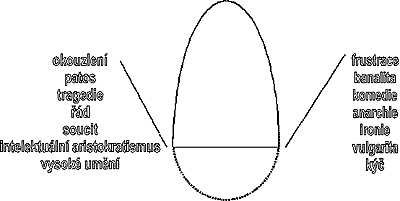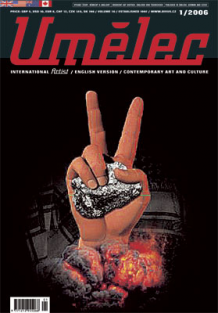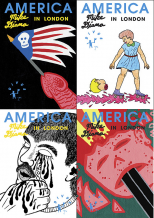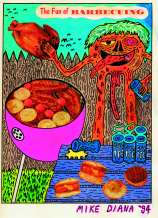| Zeitschrift Umělec 2003/1 >> Film Tetralogy — theory | Übersicht aller Ausgaben | ||||||||||||
|
|||||||||||||
Film Tetralogy — theoryZeitschrift Umělec 2003/101.01.2003 Vít Soukup | theorie | en cs |
|||||||||||||
|
"Film Tetralogy — theory
The making of a videofilm is a continual part of my work. It came about through the need to enrich the artistic aspects of storytelling, linearity and dramatic categories which I love and which I simply do not want to mix into painting or pictures. As I mentioned earlier, I am no friend of inter-field hybrid mutations. I like a fair game played by the rules in clearly separate, classical divisions. It is true that the modern era has brought into my midst a number of interesting and for me acceptable solutions to this problem. A friend of mine, Michal Pěchouček51, for example, made an animated film. He works with a systematic form of photomixing which seems very conventional to me. We have worked together on audio installations — a radio game called Come Home on the occasion of the opening of the Meet Factory. I enjoy working with and for him as an actor in some of his projects for Divus magazine and for Obludárium Theater. In this work, however, I will present my own intentionally clear-cut program, and there is no mixing of media in it. I want to use the Čipek only for classical, crystallized forms. If I do create photo comics, they have to be published periodically on the pages of a magazine and with all signs of the classical photomix as in Bravo, not hang in a gallery and be a part of some conceptualized picture installation with a somewhat artistically complicated and unclear storyline. I have the same problem with videoart. It is too artificial for me, and when I use some cheap video technique, I try to make it in my own way and through all its bizarre qualities the antithesis of classical videoart with its well-known face. Like some kind of Mathew Barney52,53 who is not at all a videoartist but a filmmaker and photographer. For me, videoart is simply a similar mutant of film done by artists like a performance of mutant theater done by practiced conceptualists. In order to explain and support this radical viewpoint, I look to The End of the History of Art by Hans Belting.54 In his book, Belting alludes to, among other things, the relationship between art and technology, the relationship between commercial and artistic use of digital video, and goes on to treat the problem of elitism of so-called media art, videoart included. It is possible and almost certain, that videoart originally had as its goal the enrichment of the world of media with a new, radical artistic experience. But it was just that elitist isolationism of the artistic community that was the reason for its isolation and run out of control. Without intense confrontation with normal people, the artist falls off into an intolerable self-fulfilling subjectivity, which is certainly possible to take when the medium is a static, hanging picture, but certainly not when it comes to moving pictures that are exhibited in a cinematographic setting. The real time and space of the visitor of a gallery is not the same as that of a visitor to a cinema — the collective experience is missing, as is the ability to concentrate. We can, it is true, talk about a certain contemplative videoinstallation as a type of medicine or oasis in a world permeated by media. But the spirit of the modern consumer of advertising and digitally inspired megafilm is simply different from that of the spirit of the audiences of the 1960s, which were influenced by the hippie movement, the popularity of Zen, a wave of Eastern meditation and the attempt of Flux and the conceptionalists to purify and deepen the language of art. It is possible that Nam June Paik was very entertaining in his time, new and refreshing. But that Gary Hill55 is, at least for me personally, worn out and boring. And so it seems logical that the tendency of today’s videoartists is moving towards greater specificity and cohesion, with more clear stories and even, in the end, a move towards the genre of film, as I might have expected. An easily accessible digital camera should influence film in a retrospective way (for example the Danish film Dogma), moving it closer to video. The process of consolidation is also obviously necessary, with mutual enrichment for both areas — hurting videoart and revitalizing cinematography. Other so-called videoartists, who are more into glitter than storytelling, are going into music videos and advertising, the same as some of today’s so-called performers are becoming the painted-on-the-wall clowns of exclusive video parties. And as for new media art, rising from protests against classical hanging art, it has become an even more snobbish product, complemented by the lifestyles of the most rich and famous. It is shocking only in its incessantly bizarre effects, with resistance equally theatrical and bogus like the satanism of Marilyn Manson. Actual film is a young muse and in spite of or maybe with the help of its compatriots television and video is the most massive and most favored artistic medium. Contrary to artistic theorists, who developed the tools of their trade before Winckelmannem, film criticism is still in a somewhat infantile stage. The new medium is developing at a turbulent pace, driven by technical innovation and the need to attract and earn. Film criticism does not have, then, at its disposal a corpse available for autopsy, as is often the case for the hanging picture or painting. In the beginning film theoreticians poetically described the advantages of silent, black and white film, in which the esthetic benefit was seen to be derived from the portrayal of abstract reality (Bela Balasz, Louis Delluc).56, 57 There was an intoxication about the novelty — the pictures moved, and critics sang the praises of the musical rhythm of pieces more perfect than poetry (Leon Moussinac)58. Then came a wave of Soviet theoreticizing directors — Vsevolod Pudovkin59 nearly fanatically converted the structure of a text to the composition of its accompanying piece, the single break coming when a person spoke and was given the welcome opportunity to view a change in the shot. Sergej Ejzenstein went even further, insisting that between every two shots there be some type of visual glitch, a still picture, and expecting that film would be a revolutionary synthesis of art and science. He hoped that this technique would become the distinguishing characteristic of the new medium and the world would follow his lead.60 (I am taking this short excursion into history because all of these conquests and somewhat mistaken notions could well be inspirational for my film tetralogy). At the same time, basically in the same year that the great silent films reached the peak of their potential, and I do indeed think that it was one of the most interesting pinnacles of film art of all time, a hoarse jazz speaker made his debut. The out-of-this-world reviews of his performances caused him at first to have his hands full — he refused them at first, then argued they were unwarranted, finally accepting them rather unwillingly. The work of filmmaking, however, took little notice of him. Hollywood not only sets the table for stardom, but it also is able to form a certain touched up and deformed Aristolian61 model, a perfectly functional schemata of the filmgoer. The main difference from Aristotle is the replacement of the tragic catharsis with the so-called peak, nearly always ending in a happy ending. From an esthetical viewpoint, this requires fluidity and an easy readability of a story and its heroes, an attractive backdrop and of course, actor-types. Screenwriter John Howard Lawson characterizes the individual parts of this schema in the following way: 1. Exposition — longer and more dynamic than in plays, containing a certain sign or symbol characteristic for the film and allowing us to get to know the characters and their conflicts. 2. The plot — the film leads to a climax of conflict, its individual scenes all leading to a key scene. 3. The key scene or climax — a culmination of conflicts, the heart of the goings-on. The symbol from 1. Exposition should play a role. 4. Culmination — an end scene, in the American conception often full of tension and violently leading to a climax and using a shortened kitschiness — mostly of course the classical happy ending.62 Contrary to the Soviet revolutionary conflictual endings, there is a certain recipe of American pragmatism transmitted, a functioning tested market which is basically unalterable. It is still in use today, even when Tarantino changes it around a bit, making himself somewhat of an avant-garde hero.63 But here we are almost moving beyond the arena or art, far away from the dreams of the film pioneers. These dreams about film which were to walk “step by step” with completely pure cinematography, meaning that certain aspects were to be excluded, to be delivered from all connections with historical, educational, romantic, moral or even immoral, geographical or documentary elements“(Jean Epstein, 1923).64 Television gave cinematography a more commercial thrust. At the same time, with its massive audiences, logically, interest in experimental and original ideas grew: the anti-films of Andy Warhol, provocation of the underground and a return to abstract film as if to vindicate the words of Jean Epstein about pure cinematography. Then, the coming of video stole from film its financial exclusivity and opened up the possibility of a whole gamut of individual modes and methods. Videoart had its place, but right now I don’t find any real answers. Besides local exhibitions or some type of coming to grips with the individual traumas of the artists themselves. Catering to the needs of a group of established snobs might have its own poetry — but it is a bit decadent. Even the guru of video Bill Viola openly says that videoart simply is and must be boring — in order to distinguish itself from television and official film production(!).65, 66, 67 The recent display Entermediale 2000 pointed to the fact that we cannot even talk about classical videoart in regard to today’s younger generation. With them, it has either transformed itself to the sphere of computer art, most often with music to the preserve of the VJ (videojockey). Or rather, for critics an even more bewildering trend, they are using more and more classical film language. The organizer of the Entermediale display Markéta Uhlířová writes that: ”…Whereas European and American activists made their own documentary films in the 1970s purposely using imperfect video, today a very quality film can be made on quality materials, even a full-length film…” 68 Since the area of Vj-ing does not at all conform to my nature, I’ll go a different direction. All of the mentioned moments from the distant past of film are inspirational for me. I would gladly accept all of the binding rules, from Aristotle’s schemata to Einstein’s precepts on editing on to the Hollywood model — and that most of all because I want to play with it, turn it around in different ways, even parody it slightly. If I had to lay down some thoughtful, ethical and esthetical world of my films, I would again use the Čipek Method, on which it is based. The first antagonistic pairs, and thereby the impetus of my film experiment, is in point A enchantment and in point B frustration. I am enchanted by the classical form of film and so I try to avoid the intellectual boredom of videoart and the stylistic bridging of media of Mathew Barney.69 I choose a more pure, banal form inspired by a refined simplicity of the great silent films, in conjunction with the naiveté of the subtitles. I am also enchanted by the intellectual elegance of Marcel Duchamp70, 71 and his perfected mechanisms of absurd drama. So I would like to construct my stories as a type of conceptual units. I am fascinated by the personal engagement and peculiar humor of Chris Burden72, and so I would like to see his films as a kind of personalized video performance — of course equipped with the dullness and pathos of real video performances. At the same time I’m frustrated by a certain isolationism of contemporary art and on the other hand a too commercial feel of cinematography — the American schema is indeed boring, but fighting hamburgers is utter foolishness. The worst part is that this prefabricated model is either completely or partly transferred over to independent filmmakers and to the earlier more personalized cinematography of smaller countries (the Czech Republic and Senegal among them). The ever-present stupidity then awakens a punk-like fury and the desire to demolish with great scorn the deep-seated forms, placing on all of them and everything one great, long nose. At point C and so in the eventual form of tragicomedy we can move on to exposed synthesis. Love for films and the pleasure of storytelling, from the configuration of new realities combined with a raging desire to parody everything and continually purify the all with nihilism. (...) Finally I would like to mention another of the pipe’s synthesized dualistic, antagonistic pairs — order and anarchy. On the one hand, at point A, there is again admiration for the classical and its greatest products. To Aristotelian dramatic logic and its application in old-style dramatic creation73, to poetic enchantment and the penetrating power of William Shakespeare.74 There is also the mentioned Hollywood scheme of Lawson — Aristotle would certainly wonder what all could be placed into his own legal order! But even he himself, though it is necessary for the right feeling of sympathy for the tragic hero, can be a source of comic inspiration. The order of my films is actually a kind of comical degeneration, a light parody of similar attempts to shackle the dramatic world of law. My schema, developed with the help of the Čipek exposition of order and chaos, could be defined as such: 1. Preliminary trouble, getting to know the characters. 2. The plot unfolds, partly retrospectively, best if completely crazy. 3. An end conflict — solution of the problem of the beginning and its connection to the story told. 4. Conclusory denouement — best if totally stupid and, after the story, completely inappropriate. It has little in common with the tragic greatness of catharsis with the dynamic elegance of the American climax. But I simply like to place human stories into this absurd structure, and I equally like to take them out of this structure. The first two films of the tetralogy hold to the structure, the third purposely ignores it and is completely linear, the fourth joins the two strategies. A classical mix with punk. I hold to the determined line sometimes quite precisely, in order to allow it to be consequently destroyed and mixed, and to allow the characters to be helplessly thrown against the rocks. How we actually did, well, you can judge for yourself during the screening. You can use the Čipek yourself in the scenes chosen. The first two interconnected films hold to the schema and tell of the return of a lost son from the world and of bees which decide to put the sun on their own horizon. The third film disturbs the schema through its unambiguous linearity, telling the story of an alcoholic who voluntarily and with peace of mind ends his own life. The fourth film, Norwegian Sweaters, in the beginning refers to, and at the same time connects, the film tetralogy with the Dorka theme. It should be a catharsis of the whole cycle, a full reconciliation. A short overview of previous resolution strategies (...) The motif of banality in pictures is obviously as old as art itself. In the early periods of art, beside the mythological and heroic subjects, there were also commonplace, banal subjects to refresh us.(...) Baroque has in the civil and banal everyday world a meaningful antipole of the extreme pathos of religious composition. Even so, in these most banal motifs we can find a mystical, creative miracle — Zdeněk Kalista75 describes it beautifully in a passage about the lace of Škrét’s portrait of the young Vitanový. The whole world of Dutch painting is a celebration of the extraordinary of the extraordinary — not in all cases of the great craft productions is this, however, adhered to. In the historical painting of the 19th century we can speak about banality undesired, even if, viewed with today’s perspective, very inspiring. It is there, where the 19th century attempted to attain maximal pathos, that it is most banal and unwillingly comic. Impressionism then brings to painting banal motifs completely planned, in natura, of course as elusive reflections where the atmospheric conditions of banality are dominant and enlightening. A banal theme is then symptomatic for a whole new modernity, to suppress the theme and make it as seemingly unmeaningful as possible. In Dada76 the use of the banal is supported by the sarcastic and destructive character of the whole movement, but with surrealism77 shocking combinations deprive it of its simplicity and sympathetic commonplaceness. With utter banality such as this, the Pop-art of the 1960s makes its debut, and this banality becomes its main medium. For me personally, Pop-art is of course unacceptably banal. It is based on show as the one possible theme, with modernistic stubbornness and directness, as a pure phenomenon without any real attributes. And in addition, it is underscored by impossible, multiply recycled forms. Pop becomes a kind of banal game, in the best case seen as a kind of social critique of consumption, which is possibly a nice topic for the ecologically minded, but not quite enough for an artwork. Still a lesson or two on Warhol can be beneficial and useful for our work. On the one hand, banality truly installs itself along with kitsch as the central problem; on the other hand, it shows that it is going nowhere. Banalized art without characteristics, emanating from one of the Čipek’s extremes, becomes just another banal language of a banal world. One proof of this could be the acceptance in its time of one of the more radical Warhol experiments on the world of advertising and mass media.78, 79, 80, 81 (...) We cannot leave out one of the great ones, Jeff Koons.82 I already mentioned in the theoretical part of this narrative my own personal opinion that Koons does not work with kitsch nor even manipulates it in any way. Koons simply purposefully and in the most direct way produces kitsch. The radicality of his approach is strong, even overwhelming, of course from the perspective of the Čipek one-sided. Schematically we could display his position in this way: We did not get the desired product, but rather an extreme outlier. I see a number of other artists in the same position, some less radical of course, but who still very intensively practice with kitsch in the realm of their postmodern work. Mike Kelley is much closer to my strategy, exactly for his very pronounced Like-like combination of sentiment and ferocity, melancholy and punk-like rebellion.83, 84 Compared to my own project, Kelley’s formal language is shattered, using a long list of concepts — installation, object, photography, text and collage. I personally prefer a more direct, clear and concentrated form. I will leave the exhibition rooms which remind one of warehouses, schoolrooms or the little messy hideaways for the utterly stoned teenagers to Mike and his colleagues. The position of the African Bodyse Isaka Kingelez is closer to my own. In his clarity and purity, in naive optimism, in these we feel the other extreme — the dark shadow of social reality. The result is luminous, effortless, playful, and most of all beautiful.85 (...) I categorize on the side of dramatic art those phenomena whose character is closer to my methodology and whose existence strengthens mine. I have already mentioned Shakes-peare, whose unending balancing act between antagonistic opposites is projected into the structure of his plays and to the content of the individual verses. Individual characters smash into each other and their worldviews, comic and tragic aspects of life, macrocosm and microcosm, banality with heroic pathos.86, 87 Another important lesson for me is dadaistic destruction, whose wild humorous features we can trace to absurd drama, punk rebellion and postmodern parody. In classical postmodernism, I am an admirer of the highly bipolar world of David Lynch88, here of course sometimes the subconscious and its dark, surreal accord dominates too greatly. In this country, the Czech Republic, the activities of the Pražské Pětky, the Prague Five, are very valuable to me, along with the films of Vorel and Trojan.89 The poetry of this group, which is also close to my heart, views the problem in a too one-sided and mechanical application of unendingly same and unlimited soft parody, all absorbing and winning out over all. The paths taken out of their own trap at their own risk by the individual creators of this generation reek of a certain opposing cheap moralization and subjective pathos. The coming generation is also close to my heart, but lightly balancing the poetry of Marek Najbrt and the people around Theater Radio and Space Encyclopedia only to a degree. Their parody is not so apparent, their mystification at times uncertain, and everything is balanced by ever-present melancholy and personal story. With Encyclopedia it is a bit of a troubling combined form. The Čipek Game should have the clearest and most well-arranged barriers. Methods and Techniques My picture series from Dorka was developed using a simple method: at the beginning there was a more or less intuitive choice of photographic materials. Photography as an introductory impulse is very important for me — I understand its role in work on a painting as the position of live scanner. A photo rolls around my head and into my body — the initial impulse must be a certain excitement on finding it. Its evaluation as a whole follows — it depends on how much it contrasts to or complements or elucidates my other work. It is also important that a painting developed from it be an independent, solitary thing, an experience in and of itself. The choice of materials is always very broad and ensures that the picture in some way is fixed in the head and at the same time conforms to the whole. I also ask for help — through a survey of visitors and observers from among my closest friends and colleagues I am able to judge the value of a certain picture. In choosing the pictures that went into Eternal Beauty, a certain esthetic attractiveness and especially decoration played an important part. I came up with a sort of anti-theory to the state of Adolf Loos’s90 Decoration and Misdeed — Decoration and Joy. It is true that according to point A the ornamentation of Dorka is truly a crime, and not only from the point of view of the historical development of society, but mostly from a psychological and ethical point of view. Contrary to renowned and famous architecture, however, I don’t understand esthetical evolution that is so Darwinian — a tattooed Caffre, Persian woven rugs and an embroidered Slovak girl are of the same value to me as a functional architect. And so in point B can be seen the consolatory sweetness of ornamentation, softened surroundings, building up a sometimes desperate or at least low feeling of ceremoniousness, enveloping those who feel it in a patterned, protected suit of armor. I don’t worship ornamentation, but I pray that our civilization does not perfect itself to the point that it disappears forever. Although I do not work with ornamentation otherwise, I take my picture series as a certain kind of brake of the eventual process of the disappearance of ornamentation, or at least a tell-tale foretelling of its eventual demise. Long live Norway and Moravian Slovakia, Persians and Zulu Caffres. Magazine pictures will continue to serve living scanners as a means to the process of painting. The pre-painting phase is very important. I welcome all possible deformations, changes in composition, color anomalies and mixed colors — as some quirky, imperfect mechanism which only picks through the work of the magazine photographer and old-style printer. Sometimes I even take the old black-and-whites and color them — this kind of mutation can only help. Oil painting as a technique is for me of utmost importance. On the one hand, as I have written, I enjoy keeping to the classical rules of the game, but also I have through the years developed an absolutely useful way of painting in three layers. The pre-paint is a colorful watercolor, which can have a flowing composition and radical texture; the second phase smoothes out the rough edges, refines the details and moulds the shapes. Sometimes it can even accentuate the meaning of the whole picture. The glaze crowns the colors like a shiny cellophane, deepening the shades and giving one last superior touch. It is a perfectly thought-out three-layer sandwich. I found the material used for the films in a similar way. At the beginning there are always finds: overheard parts of television dialogues, conversations of friends, a book on fishing, a party, some treasure found, a piece of clothing, a record with Norwegian folk songs. As time goes on, things get put into corners, or thrown away, and stories begin to develop out of them. The resulting developing stories are then refined collectively, allowed to be edited and rewritten according to a momentary inspiration, until the final shooting, when weather, the absence of props or the indisposition of one of the actors can come into play. (...) The films are silent — not from nostalgia but purely to allow them to tell the story on their own. Any associations with the grotesque world of silent films do not bother me — but I do not like the various retrofilms, which attempt to revive the classic silent film. We want to be completely contemporary, just somewhat static and silent. The abundance of words, phrases and static dialogues, not only in modern films, but in theater and everyday life, requires a certain ascetism in this direction. Titles do not mix in to the picture and require the clearest, most concise expression. Stylization, stiffness and naivete are also important, required even from volunteers and amateurs who work on any film project. These bring a kind of alienating effect91 and playfully get rid of any whiff of exaggerated pathos or on the other hand overexpressed grotesque. Conclusion I would like the following work to have a hopeful character and message to it. The message that art is alive, that it can be communicated and it does not have to be nonsensical stupidity, that it can be entertaining and not at the same time superficial, that it can work with its banality and not be at the same time banal. I want to exhibit a varied collection of oil paintings that should validate the meaningfulness of that media here and now. I want to step forward as a self-confident creator with a very personal, developed and at the same time widely acceptable and comprehensible program. I want to present my vision of contemporary electronic art by showing a short, 10-minute film which has the character of commercial art through its own entertaining qualities. And I want to show you that that is no small feat. (...) I do not want to force my model on anyone, nor do I want to achieve something generally valid. I want to offer this to you as a kind of brilliant diamond, serving to please the eye and soul and reflective in all facets of its composition and unending reality. I want to offer this to you as a possibility. I do not know any better, so I come to you with this perhaps raw, personified and imperfect ideal, and I humbly hope it will be accepted. In art, as in life, there is no greater joy than giving someone else a bit of pleasure. If it works, we just might be able to catch sight of a flash of the Eternal Secret, of Absolute Subjectivity. And you, I, we, could not wish for anything more than that. "
01.01.2003
Empfohlene Artikel
|
|||||||||||||
|
04.02.2020 10:17
Letošní 50. ročník Art Basel přilákal celkem 93 000 návštěvníků a sběratelů z 80 zemí světa. 290 prémiových galerií představilo umělecká díla od počátku 20. století až po současnost. Hlavní sektor přehlídky, tradičně v prvním patře výstavního prostoru, představil 232 předních galerií z celého světa nabízející umění nejvyšší kvality. Veletrh ukázal vzestupný trend prodeje prostřednictvím galerií jak soukromým sbírkám, tak i institucím. Kromě hlavního veletrhu stály za návštěvu i ty přidružené: Volta, Liste a Photo Basel, k tomu doprovodné programy a výstavy v místních institucích, které kvalitou daleko přesahují hranice města tj. Kunsthalle Basel, Kunstmuseum, Tinguely muzeum nebo Fondation Beyeler.
|


































 Potsdamer Str. 161 | Neu Divus in Zwitschermaschine, galerie und buchhandlug in Berlin! | Mit U2 nach Bülowstraße
Potsdamer Str. 161 | Neu Divus in Zwitschermaschine, galerie und buchhandlug in Berlin! | Mit U2 nach Bülowstraße
Kommentar
Der Artikel ist bisher nicht kommentiert wordenNeuen Kommentar einfügen